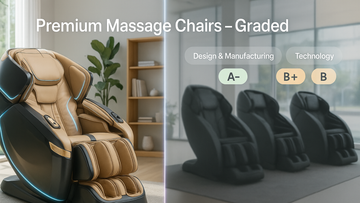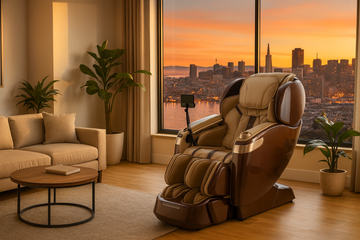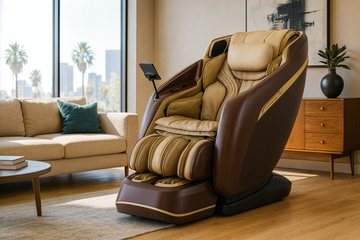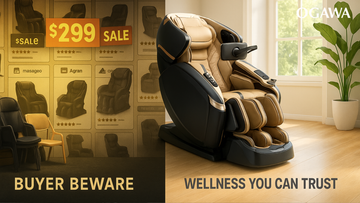The spine is the core of your body, responsible for movement and a major factor in your overall health. Without a spine, we wouldn’t be able to walk upright, support our bodies, lift objects, or function. This is why taking care of spinal health is crucial.
Simultaneously, our spine takes a beating every day! Twisting, bending, lifting, and even gravity itself all affect our spine and provide wear and tear. So then how do we combat this? The answer: spinal decompression.
Spinal decompression therapy helps alleviate damage done to your spine from your daily activities. It gently stretches the spine to reduce pressure and facilitate healing. Today we’re looking at different ways you can learn how to handle spinal decompression at home that may enhance your overall health.
What is Spinal Decompression?
Before we jump into how to handle spinal decompression at home we need to answer the question, “what is spinal decompression?”
Spinal decompression is a non-surgical method for gently stretching the spine. It works to alleviate lower back pain and facilitate spinal healing. As the spine is stretched back out from its compressed state, pressure is released from discs and taken off the nerves along the body. This pressure relief is part of why spinal decompression at home is popular for treating lower back pain and sciatica symptoms.
When you practice spinal decompression at home, discs rehydrate more efficiently as oxygen and nutrients are delivered to spinal tissue through better blood flow. This keeps a healthy back in good shape and may help with how to make an injury recover faster.
There are different methods and recovery tools available for spinal decompression at home. Healing and supporting the spine is one the largest potential benefits of massage chairs for health that anyone can experience, making them an invaluable addition. For an added experience, choosing a massage chair with zero gravity reclining capability may enhance this process.
Bonus Tip: Massage chairs and zero gravity chairs are not necessarily the same. Learn the difference between massage chairs and zero gravity recliners after this article!
Different Ways to Handle Spinal Decompression at Home
With all its benefits, it sounds like spinal decompression may be complicated but it truly isn’t. The important thing is to do it correctly in order to avoid accidental injuries that may set you back further.
Spinal decompression treats the effects of gravity and daily wear and tear on our spines to alleviate pain, decrease muscle tension, treat sciatica symptoms, and even improve sleep quality. How do you do it, though?
Let’s take a look at how to handle spinal decompression at home with ease:
- Spinal decompression stretches
- Exercises for spinal decompression at home
- Using a massage chair for spinal decompression at home
- Spinal decompression while sleeping
Note: Before trying any spinal decompression exercises, stretches, or tools be sure to consult a medical professional to ensure it’s safe for you to do so.
Spinal Decompression Stretches
Before jumping into spinal decompression exercises, make sure you've stretched adequately to prevent injury. Stretching is important before doing any exercise at home or at a gym. If you don’t stretch adequately you risk causing injury to your body, which is the opposite of what we’re trying to accomplish!
Take a look at these simple home spinal decompression stretches to get you limbered up that can also help take care of your spine in the process:
- Kitchen sink stretches
- Knees to chest stretch
- Overhead stretch
- Cat-Cow stretch
Kitchen Sink Stretches
It might sound strange at first, but “kitchen sink stretches” can make for an easy technique when learning how to handle spinal decompression at home. The steps for this spinal decompression exercise are:
- Choose any sturdy vanity (like your kitchen sink--hence the name) and hold on to the surface securely
- Slowly lean back until your elbows are completely straight, leaning all your body weight behind you
- Keep the position for 20-30 seconds, taking deep breaths
- Repeat this 2 or 3 times each day, or as needed
Knees to Chest Stretch
If you’re comfortable lying on the floor, the knees to chest spinal decompression stretch is one you’ll want to try. Not altogether different from Child’s Pose in yoga, this inverted stretch takes the pressure off the knees you may experience in the traditional yoga position.
To do this stretch:
- Lie flat on your back and bring your knees up
- Hold them using your arms and the floor will act as a counter pressure allowing the spine to gently stretch out
Overhead Stretch
The overhead stretch is the easiest stretch on our list when learning how to handle spinal decompression at home! The steps are:
- Standing or sitting up straight, bring your arms straight overhead and interlock your fingers
- Hold this position for 20-30 seconds as your comfort level allows and repeat as needed throughout your day
That’s it! This spinal decompression stretch helps take the weight off your shoulders and shoulder blades off your spine to allow it to gently decompress.
Cat-Cow Stretch for Spinal Decompression
You may be familiar with this stretch as a popular yoga post aimed at improving posture and balance while stretching out your spine. It’s an easy stretch for those learning how to handle spinal decompression at home but may be extremely effective.
The cat-cow stretch follows these steps:
- Start by getting on your hands and knees
- Position your knees directly under your hips and your hands directly under your shoulders
- Slowly arch your back as far as you can while moving your head down towards the floor
- Return to your original position, then let your back sag down towards the floor while looking up toward the ceiling
- Repeat as needed
Spinal Decompression Exercises for Home
One of the easiest ways to learn how to handle spinal decompression at home is with simple exercises. Adding these as part of your personal fitness routine may help to maintain your spine and keep your body in peak condition.
A few easy spinal decompression exercises you can do at home are:
- Kitchen sink stretches
- Foam roller back bends
- Bar hang-ups
Foam Roller Upper Back Exercise
Another easy activity on our list of spinal decompression exercises, foam roller upper back exercises help by leveraging your body weight over a foam roller (or any similar padded item). You could also use an exercise ball for this exercise, if you prefer, but may need to adjust the positioning some.
To complete this foam roller upper back exercise, simply:
- Lie on your back, placing the foam roller horizontally beneath you and across your upper back
- Interlock your hands behind your head and use them as a counterweight to the rest of your body
- Raise your hips slightly to move the roller up toward your shoulders
- Hold this position on sensitive areas for at least 20 seconds as you work your way up the body
- Work your way up to your shoulders then down to your mid-back
- Repeat this action 4 or 5 times to help align your spine and allow it to decompress
You may hear some popping in your back during this exercise but that’s okay. As long as it isn’t painful, what you’re hearing is your spinal decompression exercise working!
Bar Hang-Ups
Last up on our list of spinal decompression exercises are bar hang-ups. These are great for people who have a pull-up or chin-up bar in their home. If you don’t have one of these, you can use any bar so long as it is very sturdy and can withstand supporting your full weight without incident.
The steps for bar hang-ups are:
- Reach up, grabbing the bar firmly
- Start slowly relaxing your leg muscles and gradually increasing the percentage of your body weight hanging from the bar
- At your ideal comfort level, hold and maintain this position for 10-30 seconds
- Place your feet back on the ground, relax for a moment then repeat
Try doing this spinal decompression exercise 4-6 times each day for optimal results.
Using a Massage Chair for Spinal Decompression at Home
Another tool you may consider when learning how to handle spinal decompression at home is a luxury massage chair. The benefits of massage for health have been demonstrated through numerous studies. Today’s massage chairs have evolved beyond their lesser counterparts of decades past to now provide incredible full body massage experiences that reduce stress, help facilitate spinal decompression, and may even boost your overall health.
The available options on today’s massage chairs allow for you to choose from a variety of massage techniques to meet your needs. For example, choosing a thai massage program on your massage chair will provide a technique focused on deep stretching of muscles that may be useful for spinal decompression at home. Having a massage chair at home let’s you experience these benefits whenever you want!
Other massage chair features like heat therapy and zero gravity reclining capabilities may also serve to enhance spinal decompression at home. These features reduce muscle tension and painful spasms while keeping the body loose and relaxed. They’ve also been shown to improve your mood and relieve pain by causing your body to release endorphins.
Spinal Decompression While Sleeping
Did you think you could only handle spinal decompression at home with exercises or recovery tools like massage chairs? You may be surprised to learn that you can actually help facilitate spinal decompression while sleeping, too.
For quick naps, you might consider a short snooze while using a massage chair for spinal decompression. That said, you should only sit in your massage chair for 20 to 30 minutes at a time, so be sure not to overdo it.
To help facilitate spinal compression while sleeping, buy a mattress that offers you the support you need. Experts recommend one that is medium-firm. You also need to make sure you learn how to sleep to improve your posture, as it will help spinal decompression at home, as well. The most important thing is to have body alignment and proper support in bed. This may also help keep you from twisting while asleep, which can cause back pain and muscle tension.
Lower back pain is a common ailment experienced by an estimated 80 percent of people at some point in their lifetime. Taking care of your spine is crucial to your overall bodily health as it ties into many different systems. To help with spinal decompression at home, practice the stretches and exercises in this guide or consider choosing a massage chair for a luxury experience worth the investment. When you start actively taking care of your spine, you’ll likely feel the difference and your body will surely thank you!
Want to learn more about the benefits of massage therapy at home and how massage chairs can elevate your lifestyle? Check out these resources:
- What is a 4D Massage Chair and Its Benefits?
- 6 Ways Knee and Calf Massages Help Muscle Strain
- 4 Heated Massage Chair Benefits For Back Pain
- What is Air Compression Massage and its Benefits?





